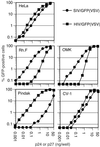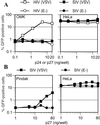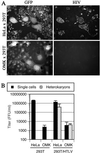Cellular inhibitors with Fv1-like activity restrict human and simian immunodeficiency virus tropism
- PMID: 12154227
- PMCID: PMC129368
- DOI: 10.1073/pnas.162299499
Cellular inhibitors with Fv1-like activity restrict human and simian immunodeficiency virus tropism
Abstract
Many nonhuman primate cells are unable to support the replication of HIV-1, whereas others are nonpermissive for infection by simian immunodeficiency virus from macaques (SIVmac). Here, we show that restricted HIV-1 and SIVmac infection of primate cell lines shares some salient features with Fv1 and Ref1-mediated restriction of murine retrovirus infection. In particular, the nonpermissive phenotype is most evident at low multiplicities of infection, results in reduced accumulation of reverse transcription products, and is dominant in heterokaryons generated by fusion of permissive and nonpermissive target cells. Moreover, in nonpermissive primate cells, HIV-1 and SIVmac infection is cooperative, and enveloped HIV-1 virus-like particles, minimally containing Gag and protease, abrogate restriction. In African green monkey cells, HIV-1 virus-like particles ablate restrictions to HIV-1 and SIVmac, suggesting that both are restricted by the same factor. Finally, a virus that contains an HIV-1 capsid-p2 domain in an SIVmac background exhibits a tropism for primate cells that is HIV-1-like rather than SIVmac-like. These data indicate the existence of one or more saturable inhibitors that are polymorphic in primates and prevent HIV and SIV infection by targeting the capsid of the incoming lentivirus particle.
Figures






Comment in
-
An intracellular block to primate lentivirus replication.Proc Natl Acad Sci U S A. 2002 Sep 3;99(18):11549-51. doi: 10.1073/pnas.192449399. Epub 2002 Aug 23. Proc Natl Acad Sci U S A. 2002. PMID: 12195025 Free PMC article. No abstract available.
References
-
- Gartner S, Liu Y, Polonis V, Lewis M G, Elkins W R, Hunter E A, Miao J, Corts K J, Eddy G A. J Med Primatol. 1994;23:155–163. - PubMed
-
- Himathongkham S, Luciw P A. Virology. 1996;219:485–488. - PubMed
-
- Shibata R, Sakai H, Kawamura M, Tokunaga K, Adachi A. J Gen Virol. 1995;76:2723–2730. - PubMed
-
- Li J, Lord C I, Haseltine W, Letvin N L, Sodroski J. J Acquired Immune Defic Syndr. 1992;5:639–646. - PubMed
Publication types
MeSH terms
Substances
Grants and funding
LinkOut - more resources
Full Text Sources
Other Literature Sources
Research Materials
Miscellaneous

